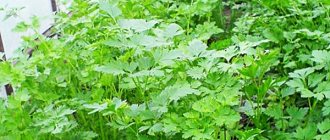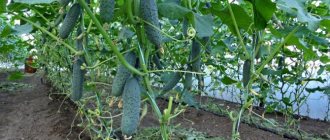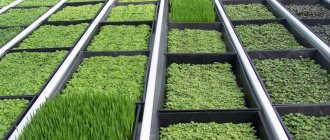Radishes are a great addition to any salad or appetizer. Vitamin-rich root vegetables are always in good demand, especially in winter, when the range of vegetables in stores is not as rich as in the summer.
Radishes are easy to grow and quick to ripen, so some gardeners also grow them in the cold season. In this article we will tell you how to organize the cultivation of radishes in a greenhouse in winter for sale and achieve success.
Features of growing radishes
In spring, you especially want fresh vegetables: after a long winter, you need vitamins and fiber. You can quickly and without much effort grow radishes on your plot, and if you also have a greenhouse, then the harvest from this amazing vegetable will appear on the table even earlier. Radish is one of the healthiest vegetables. It is rich in carbohydrates, proteins, organic acids and vitamins B 1, B 2, PP, C. This vegetable also contains a lot of potassium, magnesium and iron salts. The essential oils contained in this vegetable give it an unusual taste. Thanks to glycosides, it has a mild bitterness. Experienced gardeners know that growing radishes in a greenhouse is very simple. The main thing is that the greenhouse is located on the sunny side and is designed correctly.
Radish is an annual plant. It can be characterized as an early ripening, moisture- and light-loving plant, resistant to cold weather.
Basic information about radishes and their features
Before planting radishes in a greenhouse, you need to know the features of this vegetable:
Radish is an annual plant belonging to the cabbage class.
- Radish is an annual vegetable; it belongs to the cabbage family.
- This vegetable really loves light and warmth; if there is not enough sun, the root crops will not be large, so you need to plant it when the days are already long enough, that is, in the spring. If you plan to grow radishes in a greenhouse in winter, then additional lighting will be required.
- This vegetable can tolerate frosts down to -3 degrees Celsius.
- Vegetables will grow well at a temperature of 18-20 degrees. Extreme heat is also not needed: the root vegetables will be flabby and empty inside.
- It is important to choose the right soil in the greenhouse.
If radishes are planted in acidic soil, then there is a possibility that the root crop will be infected with clubroot. If there is not enough nitrogen in the soil, the leaves and the vegetables themselves will not fully develop, and the leaves may still turn pinkish-crimson in color. If there is not enough potassium, then root vegetables will not appear soon.
How to prepare the soil for sowing radishes
It is important that the soil for planting radishes is neutral.
How prepared the soil is for planting is how the vegetables will grow. This is exactly what experienced gardeners think. In order to sow radishes in a greenhouse in early spring, you need to take care of the soil in the fall.
- Dig up the soil in the greenhouse and add mineral fertilizers in the following composition: superphosphate about 40 g and potassium chloride about 15 g. This is the calculation per square meter.
- It is important that the soil is neutral. Acidity can cause a number of unwanted diseases. Therefore, you need to add about 1.5 buckets of compost. The calculation is also per square meter. Only on such soil can full-fledged radish root crops be grown.
- It is necessary to prepare the beds themselves in the fall, the width of which should be about a meter.
Preparing seeds for planting
When the weather becomes spring and the sun's rays begin to warm up the earth a little, you can prepare to plant radishes. First, you need to check the beds in the greenhouse again. Then you can start choosing seeds. In order for the root vegetables of radishes or radishes to be large and juicy, great attention must be paid to the choice of varieties of these vegetables.
In central Russia, radishes can be grown in the last winter months.
Gardeners recommend purchasing the following varieties:
- Zarya - this variety is stress-resistant.
- Zhara is an ideal variety, early ripening, root vegetables will appear on the table very quickly.
- Saxa is also a fast-ripening variety; large, juicy radishes will be available in a month.
- Early red is a variety created for growing in greenhouses in winter. This is one of the few varieties of this vegetable that does not require natural sunlight. It can be replaced with special lamps. This variety is adapted to grow indoors not only with artificial heating, but also with artificial lighting.
If a specialized greenhouse with a heating system is built, then it is quite possible to grow vegetables all year round. And in the conditions of the middle zone, radishes can be grown even in the last winter months in unheated greenhouses.
After the last frost has passed, you can prepare the greenhouse for planting.
Initially, you need to put it in complete order, that is, remove the remaining snow, if necessary, then repair the frame and cover it with film. Let it stand for a while, warmed up, the soil will quickly warm up. When the first 3 or 5 centimeters of soil become soft, you can begin planting. If the beds have not been prepared since the fall, then you need to wait until the soil has completely thawed, then add fertilizers and bait. Then everything needs to be dug up and leveled again, and only then can planting begin.
Planting seeds
General diagram of drip irrigation of radishes in a greenhouse using adapters.
First, the seeds are sifted through a sieve with a mesh size of about 2 mm. This method allows you to choose the best material for planting. Then the seeds are treated with potassium permanganate.
This is necessary to do to prevent various diseases. Radish seeds must be planted by hand. It is important that the distance between them is from 1 to 2 cm, and between the rows - from 6 to 8 cm. On average, seeds are consumed from 4-5 g/sq.m.
It's good if the seeds are evenly spaced. In this case, thinning will not be required. It is necessary to pay attention to the planting depth. Seeds should be placed in the ground to a depth of no more than one centimeter.
How to care for seedlings
After the seeds are sown, they need to be properly cared for in order to later obtain large and juicy root crops. A successful harvest will be achieved if the greenhouse has optimal temperature conditions and a certain humidity. If the greenhouse is built correctly, then this is not difficult to achieve.
Scheme for fertilizing a garden bed with radishes.
- It is important that during germination the temperature is about 16-18 degrees, but when shoots appear, it is better to lower the temperature to 6-8 degrees. This method will help prevent the seedlings from stretching upward. This temperature should be maintained for 3-4 days, and then again it will need to be increased from 15 to 20 degrees during the day, and at night - to 8-10 degrees.
- Moreover, it is necessary to promptly treat the beds with tobacco dust and ash in 1:1 proportions. This is a good way to save vegetables from pests.
- We need to pay attention to germination. If they are densely located, then you need to thin them out in time. The ideal option would be when the seedlings are located at a distance of 2 or 3 cm from each other. If they are cramped and are in the shade, the root crops will grow small. Thinning is also important for foliage, when the radishes are planted at a short distance from each other, that is, the likelihood of arrows appearing.
- Watering should be done as the soil dries out. But you need to pour it thoroughly. This vegetable is moisture-loving. The usual watering rate is 10-15 cm deep. It is recommended to water once every 2 or 3 days. If the weather is hot, then watering should be daily. If the soil is dry, the root vegetables will be rough, and vice versa, if you overwater, they will simply crack.
- It is important to sprinkle the soil with peat or humus. The layer should be about one centimeter. This treatment helps reduce moisture evaporation and retain it in the ground.
- After each watering, the greenhouse must be ventilated so that due to high humidity there is no disease such as blackleg.
- When watering root crops, we must not forget about complementary feeding with nitrogen fertilizers. Their rate should be from 20 to 30 g/sq.m. m.
- It is necessary to loosen the soil and timely weeding.
About collecting root vegetables
After all the work, after 35-45 days you can see the fruits of your labor, namely the first vegetables on the table. The harvest is harvested in two or three stages, and it usually ranges from 1.5 to 2 kg/sq.m.
VseoTeplicah.ru
Is it possible to create a radish bed on a windowsill?
Radishes can easily be sown in small boxes or pots, placed on a windowsill and grown into succulent vegetables. At the same time, a mature root crop will not be inferior in size and taste to its “garden” counterpart. Experienced gardeners sow radishes in this way in the fall and winter, when they really want vitamins.
Growing radishes on a windowsill
The root crop ripens 14-16 days after sowing. But before planting, careful preparation is required: there must be a suitable illuminated place, a convenient container and soil for planting. In addition, you need to be prepared to maintain temperature conditions. But first things first.
Time to plant radishes
Radishes for growing on a windowsill can be planted at any time of the year. It grows equally well in spring and winter, if all necessary conditions are met. Even in freezing cold, fruits can grow juicy and tender with proper care.
Growing radishes on a windowsill
The first living vitamins or when to plant radishes in a greenhouse
What kind of vegetable is this and where did it come to us?
Radishes, which form edible root vegetables, are members of the Brassica family (formerly called Cruciferae because of their four-petalled flowers). It was domesticated in Europe before the creation of the Roman Empire. Currently grown and consumed all over the world in its raw form as a crunchy salad vegetable with a high content of vitamins beneficial to humans. It has a huge variety of varieties in shape, root color and ripening time. Sometimes they are grown together with other vegetables as a compacting crop or as beacons in crops of onions and carrots.
The seeds germinate very quickly in the soil and form a root crop in a short time. For the vast majority of varieties, the main crop is ready for harvest within 3-4 weeks, with the exception of daikons, also related to radishes, which take several months to ripen. Some varieties are grown for seeds for oil.
Sometimes not only root vegetables are eaten, but also juicy tender leaves, which also accumulate vitamins.
The only place where scientists have discovered truly wild forms of radishes is Southeast Asia. India, China and Central Asia became secondary habitats where various forms were developed. Roman and Greek farmers at the beginning of our era introduced into the culture radishes with a round and elongated shape, a sweet and spicy taste, and various fruit colors from white to purple. The largest radish was grown in the mid-16th century, weighing 45 kg.
Biological features of cultivation
Radishes grow very quickly and you can get up to four harvests per season. Seeds in moist soil and at temperatures from +18 to +25 degrees germinate within 3-4 days. In laboratory conditions, when air and water are passed through the seeds, the first sprouts appear within 18 hours. Radishes are long-day plants, and when the daytime solstice lasts more than 13 hours, they begin to flower. The best conditions for the formation of root crops are in the range from +10 to +18 degrees. Under average conditions, the first harvest of most varieties is ready for harvest in 18-25 days; in colder temperatures, this period can extend to 6-8 weeks.
Light sandy loam soils are most suitable for the growth of root crops. It is unacceptable to bring the top layer of soil to a dry state during seed germination, as this can lead to a severe delay in the emergence of seedlings and even their death.
Radishes do not compete with weeds, so the area for sowing must be free of weeds.
After harvesting, root vegetables are stored at room temperature without loss of consumer qualities for 2-3 days, so it is recommended to store them in the refrigerator without leaves at a temperature of +3...+6 degrees.
Radish planting and care has a number of features, which we will consider in more detail.
Sowing methods or how to plant radishes correctly
It is necessary to follow simple rules in order to get friendly shoots. Planting radishes in a greenhouse is done by placing the seeds in furrows at equal distances. The depth of planting affects the shape of the formed radish. If sowed very deeply, the root crops turn out to be elongated; if sowed too shallow, the seeds may dry out, fail to germinate, and a superficial root system is formed, which provides little nutrients to the plant. The optimal seed sowing depth is 1-1.5 cm.
- Manual sowing
The most painstaking, but also the most reliable way of sowing radish seeds. It is used for small garden areas, up to 10 square meters. First, make a furrow 1-2 cm deep in the garden bed. Dry or soaked seeds are used. Take one seed at a time with your hands, gently pressing it between your thumb and forefinger, and place it in the groove. The seeds have rather delicate coverings, so they cannot be squeezed or rubbed too much in your hands; if they are damaged, they lose their viability and die. The distance between the seeds depends on the varietal size of the root crop and ranges from 4 to 10 cm. For the convenience of measuring the same distance, you can use a matchbox with a side length of 5 cm. Having laid the seeds on the bottom of the groove, they are carefully sprinkled with earth, preventing displacement. Then compact the soil from above with a light roller or wide board to improve seed-to-soil contact without over-compacting. After sowing, abundant watering is required until puddles begin to form, but do not overwater, as the seeds may float to the surface.
- Sowing with a seeder
If the bed for radishes is more than 10 square meters, then it is better to use a mechanical hand seeder.
There are various types of planters, including single-row, double-row, and belt. Their main task is to evenly distribute the seeds along the furrow. Planting radishes in a greenhouse with their help is possible only with dry seeds, since they are severely injured with this method. Before use, the seeder is adjusted to the optimal depth and seeding rate. They are usually driven by a wheel on the seeding unit. When sowing, it is necessary to control how the process occurs; to do this, dig up the soil and evaluate the uniformity and depth of sowing. If there is a deviation from the specified parameters, the seeder is reconfigured. The disadvantage of this method of sowing is the inability to correct an incorrectly sown bed, but with sufficient skill it is possible to sow a fairly large area in a short time.
- Sowing with ribbons
On quiet, long winter evenings, there is an opportunity to prepare for the fastest way to sow radishes in a greenhouse and stick the seeds on paper tapes. They should be 0.5 cm wide and 2-2.5 m long. Mark them with a pencil every 5 cm. Boil the paste from starch and water until creamy. Then, using it, the seeds are glued to the designated places on the tape. This is quite painstaking work, but it significantly speeds up sowing.
When the time comes to plant radishes, make grooves of the required depth and place prepared ribbons with seeds on the bottom. They are then sprinkled with soil, tamped down and watered. Water soaks the paste and paper and the seeds germinate freely, being at a precisely specified distance.
There are other ways to plant radishes (sowing seeds, mixing with paste and sowing through a bottle), but they do not provide uniform distribution of seeds and are not considered, because then it is necessary to thin out the seedlings.
The best sowing dates and when to plant radishes in a greenhouse
Taking into account the biological characteristics of radishes, root crops can be obtained from April to June and from September to January in a greenhouse with a film or glass cover. In winter, radishes are difficult to grow due to lack of light, but in summer, radishes bloom.
Under film covers in the spring, sowing dates are determined by soil temperature. Sowing seeds can be done when it is warmed up to +12...+15 degrees; such conditions usually occur in early April. After the emergence of seedlings, the film is opened during the day to prevent overheating of the plants, and closed back at night. When the average daytime air temperature approaches +25 degrees, the film is not closed, but is not removed in case of cold weather. Radishes in a greenhouse tolerate short-term frosts down to -3 degrees, but it is better to cover the plants when they are forecast.
After 4-6 weeks, you can sow radishes a second time in order to continue harvesting them until the beginning of summer. In the second rotation, film covers are used only during the period of seedling emergence. After this, the film is removed completely.
In the autumn in September, radishes are sown in a film greenhouse, when the air temperature drops below +25 degrees. Due to high temperatures, seeds may die or root crops may not form. Autumn radishes are the most delicious, as there is still plenty of sunlight, which contributes to the accumulation of sugar.
From November to January, radishes can only be grown in glass greenhouses. In them, temperature conditions are easily regulated by heating, so during this period sowing is done on any convenient day. During the period of germination it is maintained at +25 degrees, and during the period of growth and setting of root crops during the day + 22...+25 degrees, at night +15...+18 degrees. For winter cultivation, special shade-tolerant varieties are selected.
We hope that comprehensive information has been provided on how and when to plant radishes in a greenhouse, which will allow gardeners to harvest radishes almost all year round
grounde.ru
Delicious, slightly spicy, radishes are popular throughout the year. With the right approach, a radish growing business can bring good profits. It is especially profitable to sell vegetables in winter, during a period of limited supply. To get a good harvest, it is necessary to create conditions in the greenhouse that are as close to natural as possible.
Growing radishes in a greenhouse
Irrigation features and temperature conditions
Radishes love moisture very much, and therefore the degree of yield and taste of the root crop also depend on the regularity and timeliness of watering. Radishes should be moistened not according to any specific schedule, but depending on the drying out of the soil.
Timely watering of root crops
This is very important, because even after a few hours spent in dried soil, the fruits will become bitter and hard.
On average, watering is carried out at intervals of 3–4 days. But if there is excessive moisture, the radish rhizome can simply rot. Therefore, take care to systematically maintain a certain level of liquid content in the soil. After watering, it is recommended to ventilate the greenhouse for ten minutes.
Maintaining a certain degree of liquid content in the soil
The selected radish varieties are characterized by increased cold resistance. It is believed that this crop can survive even frosts. However, in order to get a good harvest, you should provide the radishes with comfortable wintering conditions. For seeds of the winter variety to germinate, the soil temperature must be about 2–3 degrees Celsius. But, of course, the higher the temperature, the faster the first shoots will appear.
When the seedlings hatch, for their normal development it is recommended to maintain a stable temperature in the greenhouse: 9–10 °C above zero. In this case, soil indicators should not be lower than 11–14 degrees Celsius. After a week, it is recommended to warm the room to 20 °C. This temperature regime is considered optimal for growing radishes in a greenhouse in winter, and compliance with it will ensure extremely early and vigorous germination of the vegetable.
Seed selection and treatment
For the greenhouse, you need to choose varieties that have good resistance to external influences. A significant factor is the length of the growing season.
The photo shows different varieties of radishes
Radish varieties table
By alternating planting seeds, you can harvest throughout the year.
Harvesting in a greenhouse can be done all year round
Not all seeds need to be treated before planting. On store shelves there are seeds completely ready for planting.
Types of seeds
- Hybrid - treated with drugs that protect against diseases and pests. Hybrid seeds can be sown dry.
- Varietal seeds are seeds collected independently or purchased from neighbors (market sellers). They may be infected with fungal or viral diseases and therefore need to be treated.
- Encrusted - seeds in a protective shell. The shell consists of growth stimulants. Does not require processing.
- Dried - coated with a peat-mineral mixture. The mixture provides protection and nutrition. There is no need to treat coated seeds.
Radish seeds in the photo
The purpose of the treatment is disinfection and additional stimulation of growth. One traditional method is soaking in a weak solution of potassium permanganate.
Preparing seeds before sowing
Disinfection can also be carried out using the drug immunocytophyte (one tablet per 100 ml of water). Processing time is from one to 12 hours.
The following substances are used as growth stimulants:
- wood ash.
For 100 ml of water - one spoon of ash. Soak for a day; Wood ash - epin.
For 100 ml of water - 2 drops. Soak for 18 hours; Epin - potassium humate.
For 100 ml of water - 20-25 drops. Soak for 12 hours. Potassium humate
After soaking, the seeds should be scattered on a paper sheet to dry.
Drying the seeds
Preparation
The basic components of success are the creation of an optimal microclimate and proper preparation for sowing. The speed of germination and healthy growth of seedlings depend on pre-sowing preparation.
Seed material
By purchasing seeds in specialized stores, you can be sure that they have been disinfected and treated with additional nutrients for rapid germination.
All that remains is to germinate the grains and sow those that will sprout.
Place a cotton pad or a piece of gauze moistened with warm water in a small container, place the seeds on it and cover the top with the same moistened piece of gauze.
To prevent moisture from evaporating, cover the container and leave for 2-3 days. Until the grains germinate, be sure to check the moisture content of the gauze. If it dries out, moisten it with warm water.
Soil and containers
The soil needs to be light, loose, fertile and non-acidic. You can prepare the substrate yourself from garden soil, river sand and humus mixed in equal quantities. The finished mixture is poured with a hot solution of dark potassium permanganate to destroy pathogenic flora.
Fitosporin solution also performs a disinfecting function. It belongs to the contact fungicides, which are used to prevent and treat plants from fungal diseases. For greater fertility, a full range of minerals is added to the soil, so as not to feed the seedlings in the future.
The capacity can be chosen as a general or individual one. A wooden box is suitable for general containers, and plastic or paper cups, a plastic container or egg cassettes are suitable for individual containers.
Whatever container you choose, make small drainage holes at the bottom to drain excess water. Stagnant moisture increases the risk of developing fungal diseases, especially blackleg.
Planting containers, like the soil, are treated with a dark-colored manganese solution. Disinfected containers are filled with earth and slightly moistened with warm water from a spray bottle.
Soil mixtures
You need to prepare the soil in advance, in the fall. After harvesting, it is necessary to remove the remains of plants and dig up the ground, add humus.
Soil preparation
There are several options for preparing soil mixtures. The following ratios are optimal for radishes:
- 40% field land plus 60% manure humus;
- 20% lowland peat plus 40% manure humus plus 40% turf soil;
- 60% manure humus plus 40% turf soil;
- 50% turf land plus 50% greenhouse land.
Common problems when growing radishes
No matter how unpretentious the plant is, growing it cannot be without problems. The most common of them are presented in the table below.
Table 3. Common problems when growing radishes
| Problem | Cause | Solution |
| Pulling radishes up | The plant is illuminated only on one side, the other is in the shade. | For symmetrical growth, the boxes with seedlings need to be rotated periodically so that the light hits all the plants equally. |
| Overgrowth of tops | Incorrect development of the rhizome as a result of: - frequent watering; — excess fertilizing; - lack of light; - deep location in the ground. | Cut off the tops completely to allow the plant to devote all its energy to root development. |
| Flavorless taste | “Overfeeding” with fertilizers. | Re-sow the radishes in less mineralized soil. |
| Radish cracking and bitter taste | Too obvious a difference between wet soil and dry air, irregular watering. | Ensure sufficient watering and correct temperature for development. |
Planting radishes
To obtain an early harvest, radishes can be planted starting in mid-January. The optimal temperature regime for radishes is from 0 (at night) to +15 degrees (during the day).
A few days before sowing, it is recommended to cover the ground with film for additional warming.
The photographs show the correct sowing of radish seeds
After several days, you need to remove the film, dig up the soil and mix it with mineral fertilizers. The depth of planting radishes is 2 cm, the distance between seeds is 2-3 cm, the distance between rows is 8-10 cm. Uniform planting of seeds eliminates the need for thinning. After planting, the ground is covered with polyethylene for several days so that the seeds can acclimatize.
Transplanting radish seedlings into open ground
Recommendations from experienced gardeners
- Choose the right radish varieties. Seeds intended for planting in the ground can be shot in greenhouse conditions.
- Under no circumstances should you sow seeds too thickly in a greenhouse. Even thinning may not save you from such a mistake.
- Be sure to use humus or compost to further feed the seeds.
The optimal distance between rows is the width of your palm.
How to care for young radishes?
Caring for radishes on the windowsill is quite easy. This root crop requires procedures that are also relevant for other young plants. All of them are presented in the table below.
Table 2. Measures for caring for young radish shoots
| What do radishes need? | Peculiarities |
| Watering | Radishes are watered only with a spray bottle. This method of irrigation helps not to wash away the seeds in the soil. But you need to spray generously without flooding the soil. |
| Humidity level | It is important to ensure that the soil is not too wet. High humidity can lead to the development of various diseases, spoils the condition of root crops and attracts parasites. |
| Lighting | In order for the root vegetable to be juicy and crispy, you need to provide it with sufficient lighting. When daylight is short, it is necessary to add artificial lighting in the form of phytolamps or fluorescent lamps. Radishes require 12 to 14 hours of daylight. |
| Temperature | In order for the seeds to germinate faster, it is necessary to create a temperature of +17 to +20 degrees. This root vegetable does not tolerate unbearable heat, so if possible, it is better to take it to the balcony - away from hot radiators. |
| Hardening | 4-5 days after seed germination, you need to “harden” the radishes. To do this, it is placed in a cool place with a temperature of 7-9 degrees for several days, after which it is taken back to the room. |
| Ventilation | After the first shoots appear, the film must be opened regularly to ventilate the seedlings. It is enough to do this every 2 days for 5-10 minutes. During the ventilation process, condensation on the film is removed and weeds are destroyed. |
| Top dressing | Indoor radishes do not require additional fertilizers: they can take all the necessary nutrients directly from the soil. However, if the shoots do not develop strong enough, you can feed the plant with standard compositions for open ground. |
| Thinning | If the radishes were sown in a common box, they will need thinning. The procedure is carried out when the greenery has 2-3 leaves. It is necessary to remove weak shoots, leaving only strong green seedlings. The distance between sprouts should be at least 1.5 cm. |
Radishes that grow on a windowsill in summer can intensify the process of flowering and seed creation. The reason for this is too long daylight hours. To direct all the forces of the flower to the development of the rhizome, in the evenings you need to cover the sprouts with a dark cloth.
Healthy and strong radish tops
Care
Radish is very unpretentious. The gardener will need to carry out only a few manipulations to reap a rich harvest. After the seedlings emerge, the radishes should be thinned out. If small sprouts grow too close together, the radishes may end up small and unpalatable. Thinning also helps prevent shoots.
Thinning radishes
Peat, nitrogen fertilizers, and humus can be used as additional nutrition. A folk remedy helps protect the future harvest from pests: a mixture of tobacco dust and ash. Mandatory stages of care are weeding, loosening the soil, and airing.
Caring for radish sprouts
If the temperature outside the window has dropped below normal, protect the seedlings with additional arcs placed inside the greenhouse and covered with polyethylene. Instead of polyethylene, you can use dense non-woven material.
Cover the bed with film if the air temperature is too low
Greenhouse requirements
If you plan to grow radishes in winter, then it is better to give preference to a polycarbonate greenhouse. This material has sufficient strength and is able to retain heat. For greenhouses for seasonal use, polycarbonate sheets with a thickness of 5–10 mm are suitable, for year-round use - 15 mm.
At the stage of building a greenhouse, the shelving should be calculated in accordance with the dimensions of the room, which are determined depending on the purpose of cultivating radishes - for your own use or for sale.
Basic requirements for a greenhouse:
- the presence of a basic ventilation system;
- ability to regulate temperature and humidity;
- sufficient area for planting care;
- availability of water supply;
- durability and strength of the materials used;
- possibility of organizing additional lighting.
Greenhouse heating methods
- Biological - laying half-rotted manure on the bed. A 20-centimeter layer of soil is poured over the top of the manure.
- Electric - use of a special heating cable.
A protective mesh is laid on the layer of earth, then a cable, then another mesh, a 5-centimeter layer of sand and 15-20 cm of fertile soil. Installation diagram of a heating cable in a greenhouse for heating the soil - Water heating - pipes are connected to the boiler, forming a closed heating system.
Water heating of a greenhouse - Stove - horizontal pipes that run throughout the greenhouse are connected to the stove.
A vertical pipe is installed at the end of the system. The smoke comes out through this pipe. Photo of greenhouse stove heating - Electric convectors, infrared heaters, radiators .
They are installed along the perimeter or on both sides of the beds and are turned on as needed. Location of infrared heaters in the greenhouse
Tips on the topic
A few tips will help in caring for home radishes:
- Despite the presence of artificial lighting, the crop needs natural light. That is why plants are placed on a windowsill or balcony.
- Radishes grow better in cool weather than in hot weather.
- When growing in egg cassettes, it is necessary to cut a hole at the bottom of each cell and bury the container in a box with soil. Otherwise, the growing seedlings will not have enough space to develop the root system.
- Water only with warm, settled or filtered water.
- After watering, loosen the soil, ensuring air permeability of the soil.
- Thin out seedlings if they are planted in a common container.
- Observe temperature and humidity levels.
Fulfillment of these conditions will ensure a healthy, rich harvest.
Harvest
The growing season of greenhouse and ground radishes is somewhat different: the greenhouse vegetable ripens later. On average, you can get a harvest 2 months after sowing. The process is also influenced by the variety of root crop, lighting level and temperature conditions. Gardeners do not recommend delaying harvesting: radishes should be harvested when they reach medium size, become juicy and acquire the color characteristic of the variety.
Radish harvest
Tip: Water the plants a few hours before harvesting. The optimal combination: watering in the morning and cleaning in the afternoon.
The harvested crop needs to be processed. If you do not plan to sell the vegetable immediately, along with the tops, trim off the leaves. Then rinse the radishes with cold water and lightly dry. Root vegetables can be stored in the refrigerator for 3-4 weeks.
The collected radishes need to be washed, dried and the tops cut off.
There is a technique that allows you to store vegetables for a long time. Radishes are placed in wooden boxes, the bottom of which is covered with polyethylene. Vegetables are sprinkled with a mixture of peat and sand. The sand-peat mixture protects root crops from rotting.
What varieties of radish are suitable?
For winter cultivation, it is better to choose early ripening varieties, since in winter the growing season is slower. The ripening time for such varieties is 18-20 days, but in cold weather the growth of the vegetable can be delayed up to 30-35 days.
For greenhouse cultivation, varieties are selected that are resistant to bolting, air humidity and lack of light.
The best varieties are:
- 18 days – early variety, ripens in 18-20 days, resistant to cold, no arrows;
- Heat – resistant to bolting and temperature changes, ripening period – 18-27 days;
- French breakfast – frost-resistant, early ripening;
- Saxa – resistant to excessive moisture and shading;
- Presto is ultra-early, the harvest can be harvested already on the 16th day after planting, it does not form shoots.
Growing radishes as a business
Some tips for aspiring entrepreneurs
- The more land, the more radishes. Gradually increase production.
- To ensure availability of products, plant seeds every 1.5-2 weeks.
- Focus on quality: choose varieties that produce tasty fruits.
- Work on holidays.
- In the fall, you can go on vacation so as not to sell radishes at dumping prices.
- Radishes will be in greatest demand in winter and summer.
- Grow classic varieties. Add exotics little by little, to test.
Growing radishes is a business that you can really start from scratch. Products collected on your own site are not subject to tax. Start with small sales, and if things work out, register as an individual entrepreneur. In this case, you will be able not only to sell root crops yourself, but also to supply the products to stores and the market. Be sure to indicate your field of activity when registering: agricultural production. Agricultural producers enjoy government support.
Selling radish harvest
Video - Growing radishes in a winter greenhouse
- Almost every owner of his own home sets up a cellar in his home - a place where he can store canned goods, products from the garden, and seasonal items. In a properly equipped cellar, due to its proximity to the ground, the temperature is always kept low...
No comments yet
- A garage is a multifunctional space. In it you can install and repair cars, design and make various things and mechanisms with your own hands.
What is a workbench? If a person likes to spend time in the garage doing repairs...
1 comment
- If you keep hens and chicks on your property only in the summer, then you shouldn’t worry about building a strong, long-lasting chicken coop. But if you are keeping poultry throughout the year, seriously think about how to make a chicken coop…
1 comment
- In one of the previous articles we looked at solar collectors (or solar systems, as they are also called), so we will not dwell on the principle of their operation. Let us only note that such systems do not “rest” either in winter or even in cloudy weather...
No comments yet
- Unfortunately, in our country almost no one knows about the rocket stove. Meanwhile, such a design is extremely useful in a number of cases due to the almost complete absence of soot during operation and the high combustion temperature.
Today we will talk about how...
No comments yet
- Building a staircase in a house is not an easy process, but it is doable. The main difficulty lies in calculating the angle of inclination and span parameters, because not only the ease of use, but also the durability of the structure depends on this. Durable and beautiful wood...
No comments yet
svoimi-rykami.ru
Origin and description of culture
Radishes appeared in Russia in the 18th century. The vegetable was brought by Peter I. The people of the country loved it so much that breeders began to develop new varieties adapted to the harsh climatic conditions of the northern regions. The greatest contribution to the development of new varieties was made by the Grachev family: at the 1878 world exhibition held in Paris, their greenhouse variety received 1st place.
Did you know? The closest biological relatives of radishes are not only radishes and turnips, but also cabbage and mustard.
When to sow radishes at home
Many gardeners make the mistake of planting radishes at the beginning of winter, when the days are very short. With a lack of sunlight, plants quickly become stretched and root crops do not form. To get a harvest in conditions of lack of natural light, you need to install a phytolamp above the plants. The lighting is turned on in the morning and evening hours so that the seedlings are exposed to light for at least 12 hours.
Closer to spring, it is much easier to provide plants with light - you just need to turn on the backlight for a couple of hours. Therefore, it is preferable to plant root crops closer to spring.
This article explains how to properly grow dill at home.
Sowing seeds
When checking the quality of the seeds, you threw them into water and let them swell a little. Now we need the grains to begin to germinate. Under water without access to air, developing embryos may die. As soon as the seed begins to swell, transfer it to a damp cloth and place it in a warm place. Make sure that the fabric does not dry out; you can wrap it in plastic wrap. Radishes produce roots very quickly - check the condition of the seed several times a day. As soon as you notice growing roots, start sowing immediately.
Fill the containers with soil, do not forget to put coarse sand or pebbles on the bottom for drainage. Make holes or grooves in the ground about 15 mm deep. The distance between plants should be at least 3 cm. Water the soil with warm water, spread out the grains and sprinkle them with soil. Water the plantings carefully so that the soil is compacted and there are no air pockets left. Wrap the boxes in film and place them in a warm place with a temperature of about +20⁰C. In such conditions, the grains will begin to develop very quickly and will soon sprout.
Don't forget to look at the crops. After 3 days you will see green sprouts. Open the containers and immediately transfer them to spartan conditions for hardening. The plants will not tolerate extreme cold, and at +8⁰C they will survive and grow stronger. There is no need to torment young shoots for a long time; 4 days is enough. After this, you can again put the boxes on a warm windowsill.
Root crops will ripen very quickly. In a month or a month and a half you will have eaten the entire harvest, and the end of winter will still be very far away. To ensure fresh vegetables are always on the table, sow seeds every decade. Don’t expect that in winter you can completely forget about dacha work. Growing radishes and herbs is not too burdensome, and all the work will pay off with gratitude from family members for a delicious dish.
Preparatory work
Before starting the planting process, you should prepare the container, soil, and seeds.
- Preparing containers. As a container for planting, you can use an ordinary wooden box, ceramic, plastic or metal container. Preferably a wooden or clay container. If there were other plants in this dish before, it makes sense to rinse it with boiling water and dry it.
- Soil . To plant radishes, you need a light, loose, well-drained substrate that has a neutral environment with a medium degree of compaction. The substrate is prepared from peat - 80%, perlite or vermiculite - 20% and a specialized mixture for seedlings. Before planting the seeds, water the soil with water. Experienced gardeners begin to moisten 1-2 days before planting radishes on the windowsill - they sprout faster and more friendly.
- Seeds. Before planting, you must make sure that the selected seeds are in satisfactory condition, without signs of rotting. Before sowing, for good germination, soak them in warm water (room temperature) for 20 minutes. It makes sense to pre-moisten seeds that are too old. To do this, wrap them in damp gauze for a day. The swollen seeds are ready for planting.
Pests and diseases
As in the garden, radishes in the apartment can be attacked by pests that enter the house through open windows and along with new purchased plants. Insects from home radishes must be collected by hand.
The most dangerous diseases for home radishes are:
- clubroot
- blackleg
- bacteriosis
These diseases are unlikely to be cured, so it is necessary to prevent their occurrence. For this purpose, it is necessary to water the soil before sowing with a solution of potassium permanganate and fungicide solutions.
What can I do to prevent radishes from stretching?
Sometimes a root crop grown according to all the rules can stretch upward. What to do to prevent this from happening? First, pay attention to the lighting. Perhaps the light falls on the plants from one side. If so, the radish stretches out, trying to get closer to him. Other possible reasons:
- excess fertilizing and watering;
- increased room temperature;
- lack of lighting;
- excessively deep immersion of seeds in the ground;
- excessive loosening of the soil around the sprouts.
That is, pulling culture upward is always a consequence of improper care. To prevent this from happening, you need to study in advance how to grow radishes on a balcony or windowsill correctly, and only then start planting. If this has already happened, you can try cutting off the tops completely. This will allow the fruits to grow. By the way, there is another problem that novice gardeners often encounter when growing root vegetables at home: the inexpressive taste of grown radishes. An overabundance of fertilizers is usually to blame for this.
Three conditions for successfully growing radishes on a windowsill











